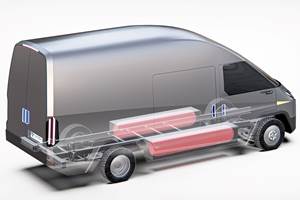Smart carbon nanotubes for wind turbine blade anti-icing system
Fraunhofer Institute for Manufacturing researches develop energy-efficient method to free turbine blades from ice in seconds.
As reported in by nanowerk.com, wind turbines have rarely been built in very cold climate zones because the risk of ice formation on the rotor blades is too high for economical operation. Even though the wind often blows with great force, aerodynamic properties deteriorate when an ice layer forms on the rotor blades as temperatures drop below zero, reducing energy production and putting the turbine at risk for breakdown. Icicles breaking off are also a safety risk.
But now, an energy-efficient heating system frees these turbines from the ice in a matter of seconds. It is only switched on when water freezes. As part of the European Union’s Windheat Project, researchers at the Fraunhofer Institute for Manufacturing Engineering and Automation (IPA, Stuttgart, Germany) are developing an energy-efficient ice detection and anti-icing (or de-icing) system for small wind turbine power generators that uses carbon nanotubes.
Existing anti-icing systems are energy-intensive, because they have to heat up the entire rotor blade regardless of whether its entirety is actually affected. The Windheat project is pursuing a different route. It divides the rotor blade into a variety of zones, each finished with a carbon nanotube (CNT) coating. A separate ice detector is then integrated into each individual CNT layer. “Our carbon nanotube coating only heats those zones that are actually iced up," says IPA scientist Anne Gerten. "These are the edges of the rotor blade, first and foremost."
The tiny, sensitive probes are constantly measuring temperature and humidity at the surface, and react to the slightest fluctuations to detect when water freezes. If ice is detected, the detectors switch on the heat element in a matter of seconds, to supply the corresponding CNT layer. Once the ice has melted, the heat is automatically switched off. “With the combination made out of CNT coating and sensors, we can target and heat the iced-up zones and essentially, only when it is actually required,” adds Gerten. The goal of the project is to increase energy efficiency by at least 18%, using this de-icing technique.
The CNT layer is just a few micrometers thick, and reportedly is easily applied to the rotor blade by spraying CNT onto a self-adhesive polymer film. Clear-coat insulates the coating and protects it from humidity and mechanical effects. The researchers selected this material because of its excellent mechanical properties. “In principle, these carbon nanotubes are wrapped layers of graphite that touch each other in various places. At these contact points, the electrical current is converted into heat,” Gerten explains.
Researchers used computer simulations to identify which areas of the rotor blades are especially susceptible to ice build-up. The edges of the blades are the most symptomati, confirmed through wind tunnel testing of prototypes realistic conditions at -30ºC in ice, rain, and wind speeds up to 120 km/h.
“We have applied affordable materials to both the sensors and the heating elements. That is an important precondition to making the anti-icing system feasible for serial production,” explains Dipl.-Ing. Sascha Getto, a colleague of Anne Gerten’s at IPA and researcher in charge of the wind tunnel tests. “We designed and built the prototypes for small wind turbine systems, but they are absolutely suitable for upscale retrofit.”
Getto considers deicing of airplane wings to also be a potential field of application for the Windheat System.
Related Content
Viritech and Haydale pursue new functionalized materials for Type V composite vessels for hydrogen storage
Goal is considerable weight savings via lightweight, impermeable pressure vessels without a liner, further advance in Graph-Pro structural storage tanks with integrated fixation.
Read MoreNanomaterials optimize performance of space-ready carbon fiber composite panels
A recent ESA project led by Adamant Composites aimed to mature nanomaterial-enhanced CFRP for lighter weight, more thermally and electrically conductive materials for manufacturing satellite structures.
Read MoreJEC World 2023 highlights: Recyclable resins, renewable energy solutions, award-winning automotive
CW technical editor Hannah Mason recaps some of the technology on display at JEC World, including natural, bio-based or recyclable materials solutions, innovative automotive and renewable energy components and more.
Read MoreUltra-lightweight skis demonstrate potential of graphene-reinforced composites
With a graphene additive, Folsom Custom Skis evolved and optimized the material makeup of its carbon fiber composite touring skis for higher performance at a lighter weight.
Read MoreRead Next
Composites end markets: Energy (2024)
Composites are used widely in oil/gas, wind and other renewable energy applications. Despite market challenges, growth potential and innovation for composites continue.
Read MoreFrom the CW Archives: The tale of the thermoplastic cryotank
In 2006, guest columnist Bob Hartunian related the story of his efforts two decades prior, while at McDonnell Douglas, to develop a thermoplastic composite crytank for hydrogen storage. He learned a lot of lessons.
Read MoreCW’s 2024 Top Shops survey offers new approach to benchmarking
Respondents that complete the survey by April 30, 2024, have the chance to be recognized as an honoree.
Read More












.jpg;maxWidth=300;quality=90)












